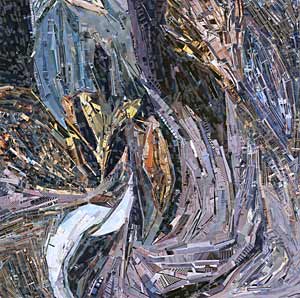Guest editor of RECORD's October 2008 issue, David Sokol, speaks with San Diego architect Teddy Cruz about form, politics, and 'repositioning practice.'
David Sokol: In this October’s “The Architect’s Hand” column, RECORD published two of your works. Border Postcard was realized in 2000. This mosaic of photographic fragments collected between Tijuana and San Diego represents how the urban infrastructure of San Diego is recycled into the fabric of Tijuana. A more recent artwork installed at this year’s Venice Biennale, Radicalizing the Local: 60 Miles of Trans-Border Urban Conflict, is a photographic cross-section of the border between these two cities highlighting these conflicting modes of development. How do these two images differ?

Teddy Cruz with Ana Aleman, Border Postcard: The Tijuana Workshop, 2000.
Teddy Cruz: The value of an image is opened up here—what our tools of representation mean. We’re trying to find our role as architects and retool ourselves to engage conflicts and crises, the conditions that are really reshaping the discourse. On one hand, our field has been burdened, as many artistic fields, with the metaphorical. So we run the risk of images that are just images—they may just be emblematic.
Built into that comment is dissatisfaction with the way representation has produced levels of commentary without producing actual tactics for intervention. Knowing that, I would say these works are mini-manifestoes for my [architectural] work. We find the collisions between top-down and bottom-up development and between natural and artificial ecologies. The image suggests that it is in the midst of these conflicts that practice should reposition itself.
The first image is built of pieces, a kind of debris of all those environments. As I traveled with students from 1994 to 2000 and beyond, it was a way of engaging the territory, witnessing these environments of conflict. 60 Miles is more literal: Let’s observe the conditions that shape the territory and the conditions from which architects have been distant, and let’s negotiate those environments in learning what’s behind them. Those conditions produce contemporary practice.
DS: Would you say there’s also a greater political need to be literal than eight years ago?
TC: Yes. As much as I’ve been seduced by academia’s excessive diagramming of conditions, I think the complexity of representation continues to hide conflicts and other issues on which economic and other policies are determined. At some point I decided I wanted to be literal, to make information that was extremely naïve, because I wanted my audience to be the general public.
As we speak about climate change, for example, we understand it as an environmental crisis. But it has to do with a cultural crisis and the definition of institutions. The telling of stories is important. Accessibility is important. As opposed to what architects do, which is to tell something incredibly simple in complex ways, a fake complexity.
DS: Does this move from abstraction to literalness represent some kind of personal change of perspective, too?
TC: Hopefully it’s a coherent development. I don’t want to reject the meaning of that abstraction, but I want to insert the meaning of that abstraction into a more political discourse. My education came out of phenomenology in the ’80s, and it stressed that we all engage in the reality of the world through our perceptions and interpretations of that reality. At the same time I feel the poetics in architecture remain too isolated from the politics of the construction of the city. And somehow many of these images should be bridges to reconnect the poetic and the political.
DS: You stress this idea of “repositioning practice.” To inform a wider public, can you provide an example of how you envision repositioning practice?
TC: When architects intervene in a particular public or private territory, we are often very naïve. We don’t know what power is invisibly inscribed in the territory. Who owns the resources? Who are the political or economic stakeholders? What values exist? By inserting our practice and research and building to expose that composition of power, we are able to then rethink what our intervention may be.
In San Diego, many neighborhoods are depressed and disenfranchised. During the most successful construction boom in the city’s history not one affordable housing project was realized in these neighborhoods. The question for me is: why?
The reason is that there is a conflict between land use, zoning, and subsidies: For a developer to build an affordable housing project profitably, this developer would have to compete for tax credits or subsidies. And in order to be competitive, this project would have to have a density of 50 units or more, which is prohibited in many of these neighborhoods.
There is a Catch-22. So what do I do as an architect? Do I build a nice condominium project in San Diego, or do I choose to have my project to enter that conflict between subsidies and land use and try to redefine or reconfigure tax credits?
DS: Is this an approach that anyone can embrace? I’m thinking of the large number of architects who shoulder mostly single-family house commissions.
TC: I’m not denouncing the rest of my peers, I just decided at some point what I wanted to do. I remember Steven Holl told me that building a practice is selecting what you really want to do, it’s about saying no to certain things. This was an area I wanted to concentrate on, but it precisely grew out of a sense of dissatisfaction.
At a time when everybody is so obsessed with hyper-design and style and formalism, it’s almost like good taste is everywhere. There is so much more potential for experimentation in these marginal areas. Everybody chooses a practice. I decided that, at this moment when the world is burning, some of us in our profession need to look at other ways of doing things.



Post a comment to this article
Report Abusive Comment